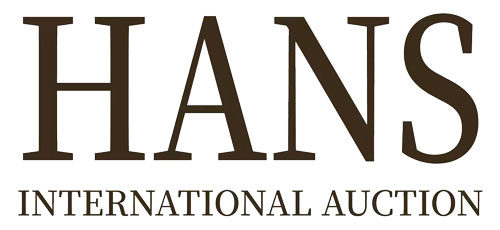Japanese home design is not only famous for its rich history and tradition, but more…
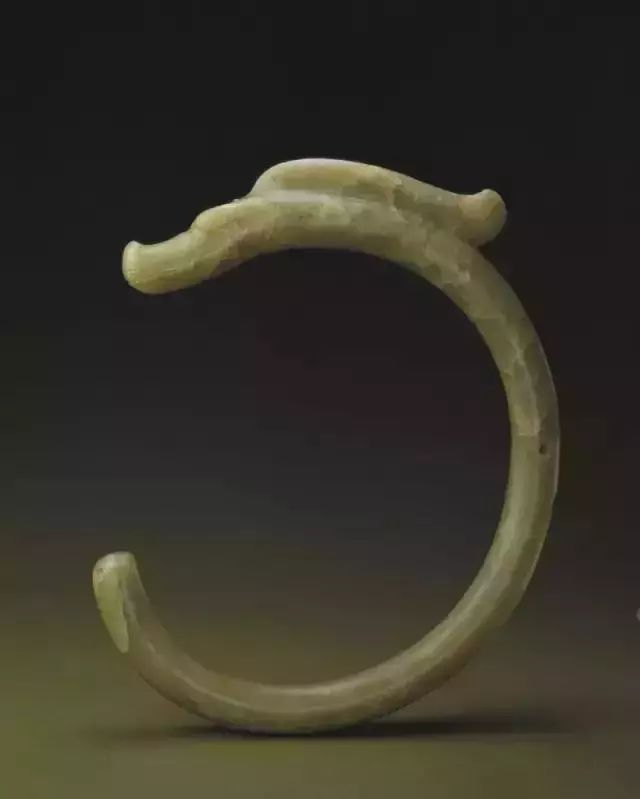
Royal Totem——Looking at the Evolution of Jade Dragon Patterns in Past Dynasties from the Collection of the Forbidden City
The dragon not only represents the supreme royal power, but also represents the heroic dream of galloping blood. The Chinese nation regards the dragon pattern as a cultural totem for more than 4,000 years, thus deriving many mysterious and mysterious philosophical thoughts, and the depth of worship of the dragon totem is rare in the world.Jade wares decorated with the image of a dragon are a large type of ancient Chinese jade wares. Their long duration, exquisite workmanship, complicated shape, varied composition and rich meaning are beyond the reach of other jade wares. From prehistoric times to the Qing Dynasty, after thousands of years of changes, dragon patterns in different periods have different artistic styles. We look at the evolution of dragon-patterned jade over thousands of years through the collection of the Palace Museum in Beijing.
1. Jade dragon patterns in the Neolithic period
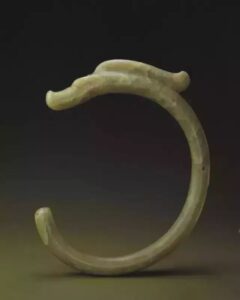
Hongshan Culture of the Neolithic Age Big Yulong
Curve length 60cm, diameter 2.2-2.4cm
Its jade material is light green old Xiuyan jade. The body of the dragon is relatively thick, curly, in the shape of an inverted “C”, with a slightly raised snout, two round nostrils, and olive-shaped protruding eyes. There is a long hyena from the top of the head to the back of the neck, and the end is raised. There are incised prismatic reticulation. The body of the dragon is flat and round, with a drill hole on the back, which can be worn with a rope.Because of its protruding kiss and protruding front end, this jade dragon is also called jade pig dragon. This is a representative work of early clan art and belongs to Hongshan culture. Its shape is exaggerated and peculiar, with both realistic and abstract techniques. Although the structure is simple, it is full of vitality, simple and rough, and may be the totem of a certain tribe.
2. Jade Dragon Pattern of Shang Dynasty
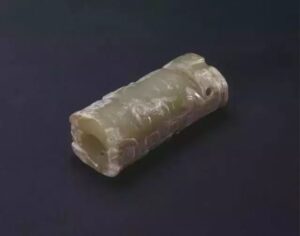
Jade Dragon Shape 0114 Shang
Height 2.3cm, length 6.5cm, width 2.5cm
“0114” (Yin Le) is made of sapphire, with a white color, cylindrical shape, and different thickness at both ends. The surface of the utensil is decorated with dragon patterns, which are characterized by the word “Chen” and decorated with heavy ring patterns and scale patterns.Jade dragons in the Shang Dynasty can be divided into early, middle and late periods according to the changes of longan. The early longan was square or diamond-shaped, and the middle and late period were in the shape of “Chen”. Heavy ring patterns and scale patterns did not appear on bronze wares until the middle and late Western Zhou Dynasty, so these two patterns on this vessel are of great significance for the comparative study of decorative patterns on jade and bronze wares.
3. Jade Dragon Pattern of the Western Zhou Dynasty
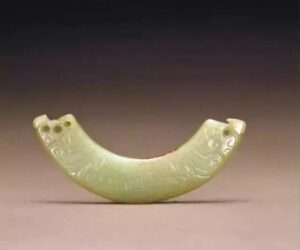
Jade Huang with Dragon Pattern, Western Zhou Dynasty
Length 1.8cm, width 1.9cm, thickness 0.5cm
Jade is cyan, pale yellow. The device is in the shape of a semi-circular sheet. It is mainly carved with the slope knife method, with the same decoration on both sides. Both ends are incomplete and seem to have halberd teeth. Has perforations for fastening.This kind of dragon-patterned jade huang was a common ornament in the Western Zhou Dynasty, and it mostly appeared in the form of a group of ornaments. It was unearthed in Shaanxi, Shanxi, Shandong and other regions in my country. The surface of jade huang is often carved with dragons, phoenixes and other patterns.
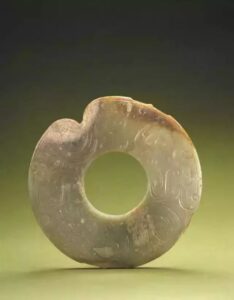
Sapphire dragon pattern bi, Western Zhou Dynasty
Diameter 16.1cm, aperture 5.9cm, thickness 4cm
Turquoise jade, with some white and brown spots. The body is flat, and there are incomplete notches on the edge of the jade material, which is irregularly round, but it is cleverly avoided in the design of the decoration. Both sides of the utensil have the same pattern, with a wide edge on the inner and outer edges, two tiger patterns engraved with incised lines on the interior and inscribed lines with a large oblique knife. The tiger walks sideways, with the word “Chen” in its eyes, long eye tips, a long tongue, feather-shaped markings on its body, and a long curly tail.The edge of this bi is missing, which may be due to the jade material. For this reason, Yugong cleverly arranged two tiger patterns, avoiding the shortcomings at the end of the curly, with ingenuity.
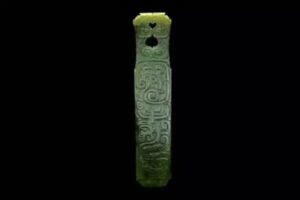
Jade dragon and phoenix handle, Western Zhou Dynasty
Length 17.1cm, width 3.7cm, thickness 0.7cm
The texture of the sapphire is green, translucent, with a small amount of soil stains in some parts, and the body is long flakes. Carved on both sides with the same ornamentation. The upper part is composed of two phoenix patterns symmetrically. The tail is drooping and rolled back into a hook shape. Two peach-shaped holes, large and small, are hollowed out between the two opposite beaks and body tails. One up and one down, it can be worn. In the middle is a long-tailed phoenix with a high crown standing tall, with round eyes and a pointed beak. The sharp claws of one foot step on the top of the head of a Kui dragon in the lower part. Short mortise, used for cuttings.Jade handle-shaped utensils first appeared in the Erlitou culture, and continued to be used in the Shang Dynasty to the Western Zhou Dynasty. However, the Western Zhou Dynasty has the most exquisite decorations, with various carving techniques, powerful knife techniques, round lines and clear decorations. There is generally a wide tenon at the lower end, which can be used as the handle of the vessel or attached to other vessels. The exact purpose needs further research.
4. Spring and Autumn and Warring States Jade Dragon Patterns

Jade Boa with Dragon Pattern Punching Teeth Spring and Autumn
Length 7.4cm, end width 1.5cm, thickness 0.3cm
Jade chongya is made of Hetian jade in Xinjiang. It is bluish white with brown spots on some parts. The device is flake-shaped, shaped like an arc-shaped long tooth, with a wide and square upper end and a slightly pointed lower end. There are holes in the middle and upper parts, which can be hung by ropes. The surface of the punched teeth is decorated with patterns engraved with Yin lines, the lines are in the shape of square folds, and there are many dragon patterns hidden in the pattern. This kind of square-folded Yinxian pattern can also be seen on some jade wares of the Spring and Autumn Period found in Shaanxi. Based on this, it is speculated that this jade Chongya is a work of the western region of my country during the Spring and Autumn Period.This piece of work is concise and dignified in shape, representing the style of Peiyu in the Guanzhong area during the Spring and Autumn Period.
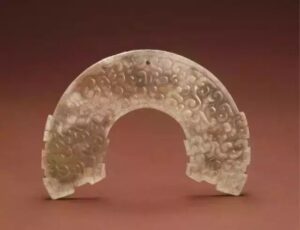
Jade dragon pattern huang Late spring and Autumn period
9.3cm long, 6.3cm wide at the widest side, and 0.3cm thick
This jade huang is made of Hetian sapphire in Xinjiang. The surface has discoloration caused by burial, and the part is yellowish brown. The body is flat, fan-shaped, and the arc is more than half a circle. This shape is very rare in the jade huang of the Spring and Autumn Period. Both sides of Huang are covered with concealed moiré patterns, and the decorations are dense, partly forming the shape of a beast face on the side. The two ends of Huang are in the shape of a dragon’s head on the side, and the edges are convex and concave along the shape of the dragon’s head.Huang-type jades were produced in the Neolithic Age and were used as ritual vessels and jade. In the Western Zhou Dynasty, it was popular to use Huang as miscellaneous pendants, and multiple jade Huangs appeared in a set of jade pendants, arranged from top to bottom. This jade huang only has a hole in the upper part and no holes at both ends. There can be no more hanging objects on the lower part. It should be the jade piece hanging at the bottom of the group of pendant jade.
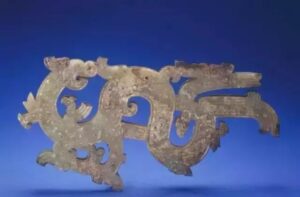
Jade carved dragon-shaped pendant Warring States Period
Length 21.4cm, width 10.9cm, thickness 0.9cm
The jade material is blue in color, with gray and brown spots of different shades. The body is flaky and dragon-shaped, with the same decoration carved on both sides. The dragon opens its mouth and looks back, its body is covered with valley patterns, a large bird is carved on its tail, and a small bird is carved on the inside, outside and tail of the dragon’s head. There is a circular drill hole in the middle of the dragon body.This device was unearthed in 1977 in the Warring States Tomb in Yanggong Township, Changfeng County, Anhui Province. The tomb belongs to the Chu tomb group in the late Warring States period, only 20 kilometers away from Shouchun, the capital of Chu State. A total of two jade pendants of the same shape were unearthed from the tomb. When they were unearthed, they were placed on the left and right sides of the human pelvis. Obviously, they were one of the group of jade pendants worn by the owner. This kind of dragon and phoenix pendant is a unique shape in the Warring States period. It is exaggerated in technique, exquisite in pattern, curly and connected in lines, and the combination of dragon and phoenix is integrated, which reflects the rich imagination of the creator. This vessel is large, intact and exquisite, which is really rare, showing the noble status of the owner of the tomb.
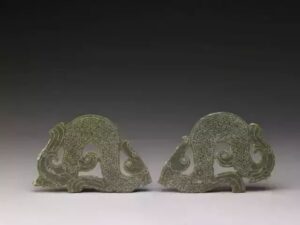
Jade Dragon Warring States Period
Length 16.4cm, 16.2cm, width 11cm, 11.2cm, thickness 0.5cm
The jade is greenish in color, with brown, black spots and flocs inside. Make a flat dragon shape, the dragon body is curved, and the Yin line outlines the outline. The surface is subtracted from the bas-relief valley pattern. Drill a hole in the dragon body for hanging.During the two-week period, along with the formation and development of the concept of virtue and jade, jade used in rituals has achieved unprecedented development. As a result, jade wares have evolved from primarily ritual objects for primitive religious activities, sacrificial vessels for offering sacrifices to gods and ancestors, to ornamental ornaments with specific connotations and relatively fixed combinations. Its length, the complexity of the structure, the quality of the jade, and the roughness of the grinding are often related to the identity of the user. Although the shape and structure of the group pendants are different in different historical periods, most of them are decorated with jade pieces of various shapes, or supplemented by beads of other materials, which are intertwined and combined. These jade pendants worn during his lifetime are usually of fine quality and workmanship.
In ancient China, jade was believed to have the function of protecting the immortality of the dead, so jade objects were often buried in tombs. These jade wares can usually be divided into two categories: one is used during life and buried after death, called burial jade; the other is specially made for corpses, called mortuary jade.This product is a typical jade dragon-shaped pendant in the Warring States period, but the material is not refined and the grinding is rough. It should be a part of the jade pendant specially made for burial, which belongs to the burial jade. Similar sapphire dragons are still seen in tombs from the Western Han Dynasty.
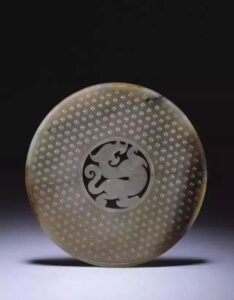
Jade Carving Chi and Dragon Combined Warring States Period
Diameter 11cm
Qing Palace Collection
This bi is made of Hetian Qingbai jade in Xinjiang, partially discolored, round, with slightly flat inner and outer edges. Both sides of the bi are decorated with raised grain patterns, which are arranged in staggered oblique lines, and the grains are in a spiral shape. A chilong is engraved in the hole of the wall.
Grain-patterned biscuits were common jade wares during the Warring States period. This jade biscuit is more refined than the general Warring States-grained biscuits. The carved Chilong has a thin neck and a thick body, with slightly protruding muscles, and its chest seems to stand upright. The tail itself rushes up and sticks to the neck. Since the Shang and Zhou Dynasties, the representations of ferocious animals have mostly focused on the head, while the representation of the body shape has been insufficient. The depiction of the Chilong’s body posture in this Warring States Bibi is extremely vivid, which is a major progress in the expression of plastic arts. The work is cut in half from the middle to form a pair. Judging from the cut, it is not the original design, but it should be a temporary result of a major event.
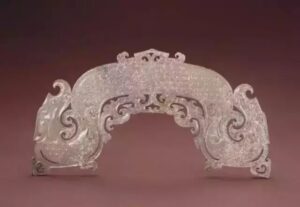
Jade Carved Double Dragon Headwear Late Warring States Period
Length 13.5cm, height 7cm, thickness 0.3cm
Unearthed from a late Warring States tomb in Yanggong Township, Changfeng County, Anhui Province in 1977
Made of sapphire, colored and spotted, flake-shaped, and overall in the shape of a “bow”. The pendant takes the midline as the axis of symmetry, butts against the double dragons, the carved dragons at both ends look back up, and the lips and kisses are curled and exaggerated. The body of the dragon is short and wide, decorated with raised valley patterns connected by short Yin lines. The upper and lower sides of the outer part of the pendant are engraved with cloud patterns, and the upper and lower corners have engraved holes for strings.This jade pendant is the central jade piece in the middle of the group of jade pendants. This kind of half-length dragon jade pendant with forelimbs is very rare in Warring States jade pendants.
5. Dragon pattern of Han Dynasty
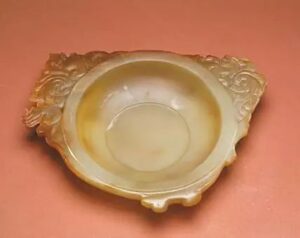
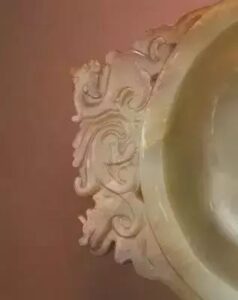
Washing with Jade Dragon Chi pattern, Han Dynasty
Length 16.8cm, width 14cm, height 2.8cm
Old Collection of the Qing Palace
The jade material of this vessel is cyan, round, and the inner chamber is very shallow, which can store water. The mouth is wide and flat, with flaky stalks on both sides. The left stalk is decorated with a dragon and a chi. The head of the chi is like a tiger with horns. The handle on the right side is decorated with a long body dragon with one horn, and its body is also hidden in the cloud water. The back of the handle is engraved with negative lines, which is similar to the front pattern.
6. Jade Dragon Pattern of Song Dynasty

Jade Cloud Dragon Pattern Furnace, Song Dynasty
Height 7.9cm, caliber 12.8cm
Furnace sapphire quality. The body is round, with a protruding mouth, no neck, a drooping belly, circled feet and outwards, symmetrically decorated with animal heads and swallowed ears on both sides. The whole body takes the pattern of “gong” as the ground, and is decorated with patterns of wandering dragons, auspicious clouds and sea water. A seven-character poem by Qianlong is engraved on the inner bottom of the vessel:
The temple utensils in He Nian praised the Scriptures, engraved as the four spirits of Feilong Temple.
Mao Bo Xinghou was different from the Zhou system, and his ancestor Ding Fugui was similar to Shang.
I still read Sanghai, but it is a pity that I met Bingding as a salary.
Rustic suet Xu changes, only the clouds and water are pale and blue.
At the end of the “Qianlong and 1898 Mengqiu Royal Inscription”.
In the Song Dynasty, under the influence of Neo-Confucianism’s thought of “investigating things to gain knowledge”, literary appreciation became fashionable, and the research on bronze wares of the three generations was also quite fruitful. As a result, another category was added to the shape of jade wares in the Song Dynasty, that is, antique bronze jade wares, referred to as antique jade wares. This vessel is based on the bronze gui, but there are many changes in the shape and decoration of the vessel, and the jade material is not yellow.
7. Jade Dragon Pattern of Yuan Dynasty
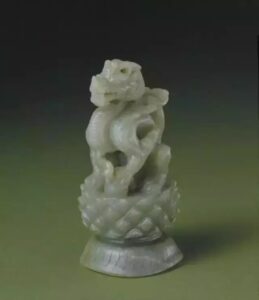
Sapphire lotus squatting dragon yuan
Height 13cm, bottom diameter 6.4cm
The sapphire has cracks, ink spots, and yellow-brown ooze in some parts. The round sculpture sits a dragon on a lotus seat. The dragon held its head high, grasping the flame bead with one claw. Double horns, eyebrows slender, extending back. With the spine on the back, the elbow hairs are engraved on the joints and then raised. The knife technique is strong and rough, leaving obvious excavation marks on the openwork. There is a large hole in the center of the bottom and a small hole on the side, so it is speculated that this product should be fixed on other objects.
The dragon is a god in ancient Chinese legends. It is a complex of various animals. Its appearance is related to the demand for rain in the agricultural society. Therefore, the legendary dragon is often able to spread rain, and it is also called the phoenix that can summon the wind. The dragon and the phoenix later became the symbols of the emperor and empress respectively. At present, the earliest image of a dragon can be found in the Chahai site of Xinglongwa Culture in Inner Mongolia 8,000 years ago, and it is made of reddish-brown stones. Dragons and dragon-related images such as Chi and Kui were important decorative themes in ancient China. During the Song and Liao dynasties, the images of dragons were quite rich, including rising dragons, walking dragons, and sitting dragons, each with its own modality, and most of them walked through the sea of clouds. A jade sitting dragon was unearthed from the site of the Liao Dynasty, but it was carved in pieces and was relatively small.
The eight dragon kings in the Indian Buddhist scriptures are the followers, supporters or patron saints of the Buddha. This product combines dragon and lotus, reflecting the influence of Buddhism on jade carving.
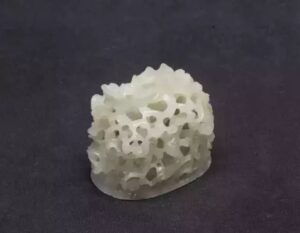
White Jade Carved Panlong Furnace Top Yuan
Bottom diameter 3.7cmX5.3cm, height 4.8cm

A sapphire sun-burned and carved dragon top with peony stove, Yuan Dynasty
Length 6.8cm, width 5.8cm, height 7.2cm
8. Jade Dragon Pattern of Ming Dynasty
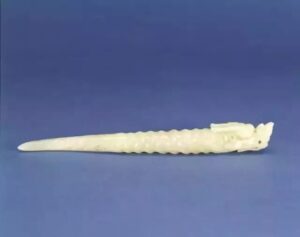
A white jade dragon head, early Ming dynasty
Length 16.6cm, width 1.7cm, height 2cm
The quality of the jade is white, the jade is warm and moist, and there are yellow strands of jade. The jade scorpion is conical, with a dragon head, a nine-section spiral pattern on the body, a plain tail, and a slightly curved tail tip. There is a vertical hole in the mouth of the dragon, and a horizontal hole in the upper lip of the mouth for hanging.
Xi first evolved from the animal teeth that untie knots. “Shuowen Jiezi” says: “xi, wearing a horn, the sharp end can untie knots.” It shows that xi is used to untie ropes, and its main feature is that one end is sharp. The earliest ancient people made it from animal bones or teeth, and wore it on their bodies to untie knots. The xi made of jade gradually lost its original function and became a symbolic ornament. “Suo Yuan·Xiu Wen Pian” said: “Those who can cure troubles and chaos wear xi.” It can be seen that xi has the meaning of curing troubles and chaos in the eyes of the ancients.
Acquired in 1960, this jade xi, headed by a dragon, is very rare, and the workmanship is also very exquisite. It may have been used by the royal family.
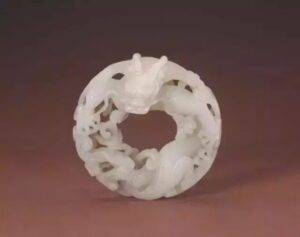
White Jade Panlong Ring Pei Early Ming Dynasty
Width 6.8cm, height 6.7cm, thickest 4.5cm
Old Collection of the Qing Palace
Peiyu is white and moist. The vessel is in the shape of a panlong. The dragon has double horns, and the dragon’s hair flutters backwards and on the left and right sides, and the hair is thin and regular. The dragon head has raised eyebrows, long beards on the left and right, bared teeth and cleft mouth. The dragon body is coiled, with five claws and a bald tail, surrounded by curly grass and cloud patterns. The side of the back of the ring wears a raised square arch, with high relief cloud patterns on it. The whole vessel is attached with a red sandalwood base, carved with cloud patterns, and the reverse side of the wooden base is engraved with the word “C” filled with gold, which is the grading word for cultural relics in the palace of the Qing Dynasty.
This encircled pendant with majestic and vigorous dragon decoration, and its engraving technique also has the style left over from the Song and Yuan Dynasties. It is a representative of court jade carving in the early Ming Dynasty. The shape of this object is rare, and it may be a belt ornament when viewed from the back. It was originally collected in the Yongshou Palace of the Forbidden City.
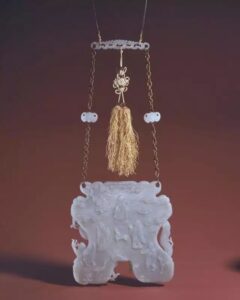
Jade character chime with dragon pattern, mid Ming Dynasty
Length 20.4cm, width 20.1cm, thickness 0.9cm
Old Collection of the Qing Palace
The jade chime is blue and white, and there is an openwork double-dragon beam on the top, with copper-plated chains hanging on both sides of the beam, and a chime hanging below it. On the front of the chime is a cloud-patterned ground, carved with a pattern of two dragons playing with fire beads. The two dragons are one up and one down, occupying the left and right halves of the jade. On the back, there are three statues of Fu, Shou, and Lu carved in relief, and there are also pine trees, deer, cranes, ganoderma lucidum and two waiters, which means “three stars shining brightly”.
Chime is an ancient musical instrument, usually in groups of many pieces, arranged in musical scales. This jade chime is a single piece, an ornament for interior decoration evolved from a musical instrument. The pattern of double dragons playing with pearls is an important pattern commonly used on palace utensils in the Ming Dynasty.
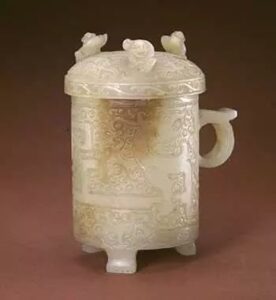
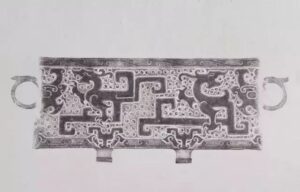
Jade Beast New Year’s Dragon Pattern Vase Ming Dynasty
Overall height 11.2cm, caliber 6.2cm
Old Collection of the Qing Palace
The bottle jade material is blue and white, slightly yellow. Cylindrical, with a ring-shaped cup handle on one side and a wrench on the upper part of the handle. The bottle has a deep belly, a flat bottom, and 3 legs below it. The outer wall of the bottle body is decorated with dragon patterns and grain patterns, and the lower part is decorated with animal face patterns on nearly three feet. On the top of the cover, three animal-shaped buttons are carved at equal distances, resembling sheep, and the middle part of the cover is decorated with swirl patterns.
Bottles are ancient wine vessels, which were popular in the Han Dynasty. Copper, lacquer, and jade works are common. This work is similar to the jade bottle of the Han Dynasty, but the pattern has changed slightly, and the craftsmanship is not as exquisite as the works of the Han Dynasty. There are many antique jade bottles from the Ming Dynasty in the old collection of the Qing Palace, and a representative work inscribed by Lu Zigang was also found in archaeological excavations in the Beijing area. Lu Zigang was a master of jade management in the Ming Dynasty, which shows the status of such works in the jade wares of the Ming Dynasty.
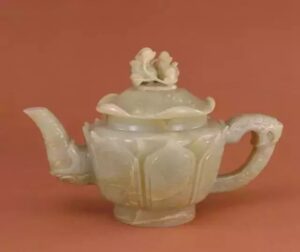
Sapphire mandarin duck lying on lotus cloud dragon handle holding pot, Ming Dynasty
Caliber 9.7cm, bottom diameter 7.6cm, height 15.6cm
9. Jade Dragon Pattern in Qing Dynasty
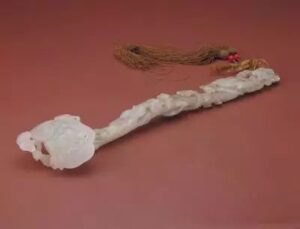
White Jade Dragon Phoenix Ganoderma Lucidum Ruyi Qing Dynasty
Length 38.8cm, head width 10cm, head height 5.5cm
Green and white jade quality, with flecks. Ruyi head is embossed with one large, two small and three Ganoderma lucidum, as well as bats and flame beads. The height of the handle is embossed with a dragon and a phoenix holding a peony, with small ganoderma lucidum in between. The dragon has a ridge on its back, its eyes are pierced, and its body is covered with engraved dragon scales. The phoenix eyes are engraved, and the eyeliner is slender and soft. The end of the handle is perforated, and it is tied with bright yellow tassels, which are adorned with two red coral beads.
Ruyi is a kind of utensil that symbolizes auspiciousness. It is developed from the ancient scratching tool and the claw stick with the front end in the shape of a hand. The head is mostly in the shape of ganoderma or cloud, and the handle is slightly curved, for fingering and viewing. Its materials are various, including bone, horn, bamboo, wood, copper, iron, jade, stone, coral, amber and so on. The so-called “Ruyi”, that is, as the meaning of people, is the free translation of the Sanskrit “Analud”. During the Six Dynasties period, ruyi was a thing for talking, helping dancing, displaying elegance and even self-defense. Documents record that during the Three Kingdoms period, Sun He held a crystal wishful dance under the moon; Wei Rui, a famous general in the period of Emperor Liang Wu of the Southern Dynasties, even when the two armies were at war, commanded the army to advance and retreat with a wishful hand; It is also used as the image of holding Ruyi. Yuntou Ruyi was first unearthed in Tang tombs. In the Song Dynasty, it developed into indoor furnishings, and in the late Ming Dynasty, it became an indispensable thing for the study. In the Qing Dynasty, because of its auspicious meaning, Ruyi was the first choice for ministers to congratulate the royal family’s birthday, and it often ranked first in the list of gifts. Palaces and bedrooms are often decorated with ruyi, and portraits of emperors often see people holding ruyi. In the Qing Dynasty, there were both Ruyi cloud head style and Ganoderma lucidum style, and most of them were made of precious materials such as jade, gold, coral, gold, crystal, etc. Ruyi with three jade stones inlaid on wooden handles was also common.

Sapphire Double Dragon Pattern Water Cheng Qing Dynasty
Height 6.9cm, length 13.1cm, width 11.7cm, diameter 4.1cm
The water Cheng is made of sapphire, round and hollow inside the mouth. Outside the belly of the vessel are embossed cloud patterns and double dragons playing with beads, and the heads of the two dragons lie on the outer edge of the mouth of the vessel. A Qianlong imperial poem inscribed in official script on the outer bottom of the vessel:
Attacking Xiao Zhou is elegant, imitating Han’s speech. If the cloud is suspicious, the dragon will also do it.
Caressing hands wants to be moist, and Cheng is full of nourishment. It’s also like answering a real bowl, I wish you can show lotus rutabaga.
Department of payment: Qianlong Jiazi Zhongchun, imperial inscription. Attached are two free chapters of “Guxiang” in Yin engraved seal script and “Tai Pu” in Yang engraved seal script.
This water cheng is a container specially used for holding water on the desks in the palace. Because the amount of water used for grinding ink is small, the body of the container is also small and exquisite. The jade quality of Shuicheng is pure and smooth, and the carving of Yunlong is vivid and vivid, all of which correspond to the meaning of Yingying water.
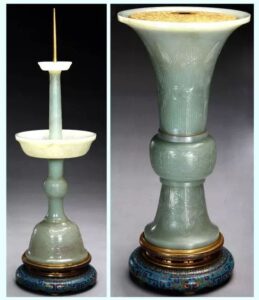
Qingyu Shouzi Banana Leaf Chilong Flower Goblet, Qing Dynasty, 28.8cm high, 16cm in diameter, 9.7cm in bottom diameter (left)
Qingyu Shouzi Candlestick with Gouyunkui Dragon Pattern, Qing Dynasty, jade platform height 39cm, maximum diameter of plate 16.2cm, bottom foot diameter 12.7cm (right)
The candlestick is made of Hetian sapphire, which is warm and moist. It is made of bottom feet, two pillars, two plates and copper brazing. There are four groups of embossed lotus petals and wishful cloud head patterns on the top of the small plate, and on the top of the truncated column. Four sets of cloud patterns are embossed on the inside of the middle plate, and two sets of Kuilong patterns are embossed on the belly of the outer plate. Kuilong has a protruding face, big oval eyes, a big cloud-shaped nose, and the body curls and extends to both sides. The lower truncated column has a bulging belly, on which are carved four groups of double chi group “shou” characters. The bottom foot is in the shape of an inverted bell, embossed with lotus petals, wishful clouds and two sets of dragon patterns. The dragon head is protruding and exaggerated, and the body curls back to the sides. Candlesticks rest on bronze cloisonné enamel bases. The enamel base is decorated with fretwork, lotus-covered patterns and animal-mask patterns, which are in the same style as jade candlesticks, which shows that it was a unified design at that time.
A pair of candlesticks is one of a group of offerings. Generally, a set of five offerings includes an incense burner, a pair of candlesticks, and a pair of flower cups, which are called “five offerings”. The five offerings, also known as the “five offerings”, are five offerings of incense, flowers, lamps, water, and fruits that are offered on the altar. The incense is inserted in the furnace, and it can go up to the three realms and ten heavens, and go down to the nine secluded and five realms. The flowers are inserted in the flower cup, and the strange flowers of the heavens are dedicated. Lighting the candlesticks illuminates the heavens, hells, and my body. Water is the precious syrup dedicated to the heavens, purifying ghosts and restoring their true form. Because of the precious fruit of Qionglin dedicated to the heavens, it has the meaning of harvesting fruit. This set of five offerings, including this pair of candlesticks, was originally displayed in the Compassion Palace and used by the Empress Dowager.
The flower goblet is made of Hetian sapphire, and the jade is warm and moist. It is made of three joints, with a bell mouth, ring feet, and a drum-shaped waist. The upper and lower sections of the body are carved with large and small banana leaf patterns, and the blade is sharp. Four groups of chilongs are engraved on the waist and belly of the drum, and the characters “shou” are held in groups. The chilongs face each other in pairs, and their bodies are curved in a geometric shape. There are copper guts and a copper cover in the chamber of the flower gu. The center of the copper cover is a round square hole money pattern, and five bats piercing cloud patterns are chiseled on the four sides on the fine pearl ground.
There is a pair of flower cups, both of which have original copper-bodied cloisonné enamel seats, decorated with fretwork, lotus petals and animal faces.
This flower goblet is shaped like a bronze goblet and is lined with copper gall for flower arrangement. This pair of flower goblets, a pair of candlesticks and a tripod-style furnace are a group, collectively known as the “five offerings”. The five offerings are offered to the ancestors of Buddha and Taoism, also known as “five offerings”, which means that five kinds of sacrifices “incense, flowers, lights, water, and fruits” are offered on the altar. In addition to various physical explanations for the five offerings, there are also different views in Taoism. For example, Zhu Quan said in “The Emperor to the Taiqing Jade Book” that the five offerings represent the five elements, gold, wood, water, fire, and earth, to represent the good fortune of heaven and earth, and the rule of mutual generation and mutual restraint. , and coincides with the virtue of the gods. The five offerings are used as auspicious objects and are mostly used in sacrificial ceremonies. This set of five offerings, including this pair of candlesticks, was originally displayed in the Compassion Palace and used by the Empress Dowager.
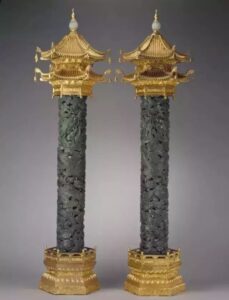
Jasper Carved Cloud and Dragon Incense Tube, Qing Dynasty
Height 76.4cm, diameter 12.8×12.9cm
The incense tube is composed of three parts, the upper part is a gilded copper pavilion-style top cover, the middle is a jasper cylinder with cloud patterns and dragon patterns engraved on it, and the lower part is a copper tire Xumi-style base. There are a pair of incense tubes, placed on the left and right sides in front of the throne. Whenever the emperor ascends the seat, sandalwood is lit in the incense tube, and the cigarettes emerge from the holes in the incense tube, creating a mysterious atmosphere of burning smoke and pleasant aroma. The meaning of all peoples. In the archives and documents of the Qing Dynasty, this device is often referred to as the “Changing Grace Incense Tube”.
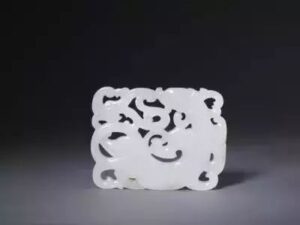
White jade carved antique Kuilongpei Qing Dynasty
Length 7.1cm, width 5.1cm, thickness 0.6cm
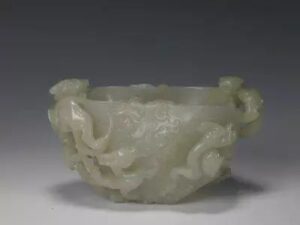

White jade cup with dragon, phoenix, cloud and chi pattern, Qing Dynasty
Overall length 13.3cm, widest 9cm, overall height 7.2cm
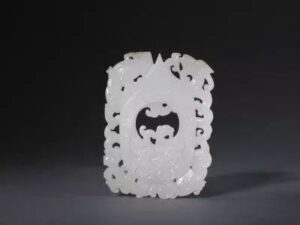
White Jade Dragon and Phoenix Pattern Chicken Heart Pendant Qing Dynasty
The overall length is 7.9cm, the widest is 6.1cm, and the thickest is 0.6cm
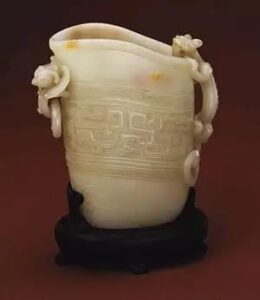
A White Jade Kui Dragon Pattern Pan Chi Gong, Mid Qing Dynasty
Height 14.2cm, caliber 9.6×5.2cm
The quality of Gong Baiyu is slightly flawed. With an open belly and a stout body. The main body is decorated with Kui dragon patterns, and the mouth and the upper and lower edges of the main body are each decorated with fretwork for a week. The stream is decorated with a phoenix head, a living ring under the head, and a pan-chi-shaped handle. The utensil is equipped with a rosewood wood base.
Si Gong is a kind of Shang Zhou bronze wine vessel. Among the jade wares of the Qing court, there are many imitations of Si Gong, with different shapes. This vessel is named Panchi Gong because of the chi-shaped handle. Its shape is smooth and its decoration is regular. Compared with the bronze Gong, although there are many differences in shape and decoration, the ancient flavor still exists.
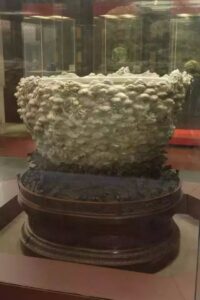
Sapphire Urn with Cloud and Dragon Pattern, Qianlong Period, Qing Dynasty
It is 70cm high and 119cm wide. Weighs about 2500kg
Commonly known as “Fuhai”. The raw material of Yushan comes from Khotan, Xinjiang, and it was carefully carved by Yangzhou Jade Workers over four years, and it was completed in October of the forty-fifth year of Qianlong in the Qing Dynasty (1780). Nine dragons are carved on the urn, and Emperor Qianlong’s book “The Story of the Jade Urn” is engraved on the bottom. Under the urn is a bronze seat with seawater patterns. It symbolizes “happiness is like the long flowing water in the East China Sea”.
This urn is made of heavy jade and is finely carved, representing the craftsmanship level of Yangzhou jade wares during the Qianlong period.
It is now displayed in Le Shoutang.
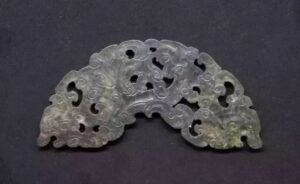
Jasper Carved Kuilonghuang Qing Dynasty
Length 14.8cm, width 5.2cm, donated from Zhang Naiqi
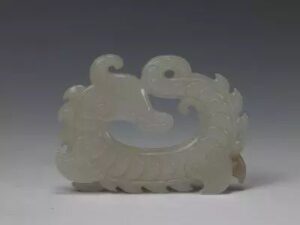
White Jade Dragon Pattern Wearing Qing Dynasty
The longest is 7.9cm, the widest is 5.9cm, and the thickness is 0.8cm
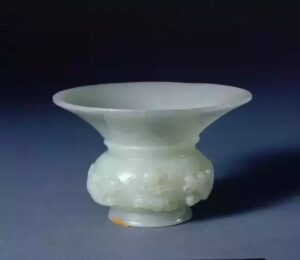
Sapphire dragon and phoenix slag bucket, Qing Dynasty
Height 7.1cm, maximum diameter 11.5cm

White Jade Spittoon with Dragon Pattern, Qing Dynasty
7cm high, maximum diameter 10cm

White Jade Carved with Chilong Pattern, Qing Dynasty
The longest is 7.5cm, the widest is 6.3cm, and the thickness is 1.8cm
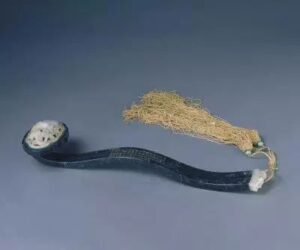
Ink Jade Inlaid White Jade Panlong Ruyi Qing Dynasty
The overall length is 40.5cm, the overall height is 8.8cm, and the widest ruyi head is 9.8cm
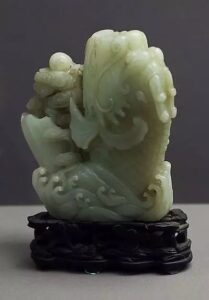
Sapphire Dragon’s Head Fish Flower Set Qing Dynasty
Height 18cm, width 17.7cm, thickness 7.6cm
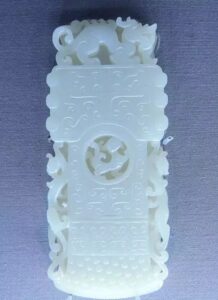
A White Jade Carved Dragon Chi Ax Wearing, Qianlong Period, Qing Dynasty
Length 13.2cm, width 5.7cm, 0.7cm
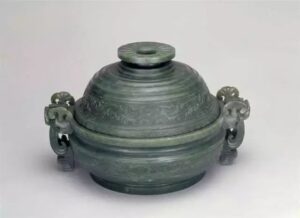
、
A Jasper Gui with Beast Ears and Dragon Pattern, Qianlong Period, Qing Dynasty
Height 17.6cm, caliber 23.1cm
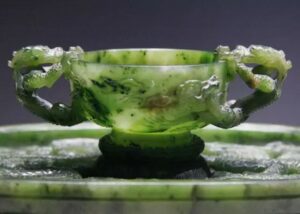
Jasper dragon ear cup with holder Qing Qianlong
Cup height 3.8cm, caliber 6.3cm, foot diameter 3.3cm
Plate height 2.5cm, caliber 11.9×17cm, foot diameter 9×13.9cm

